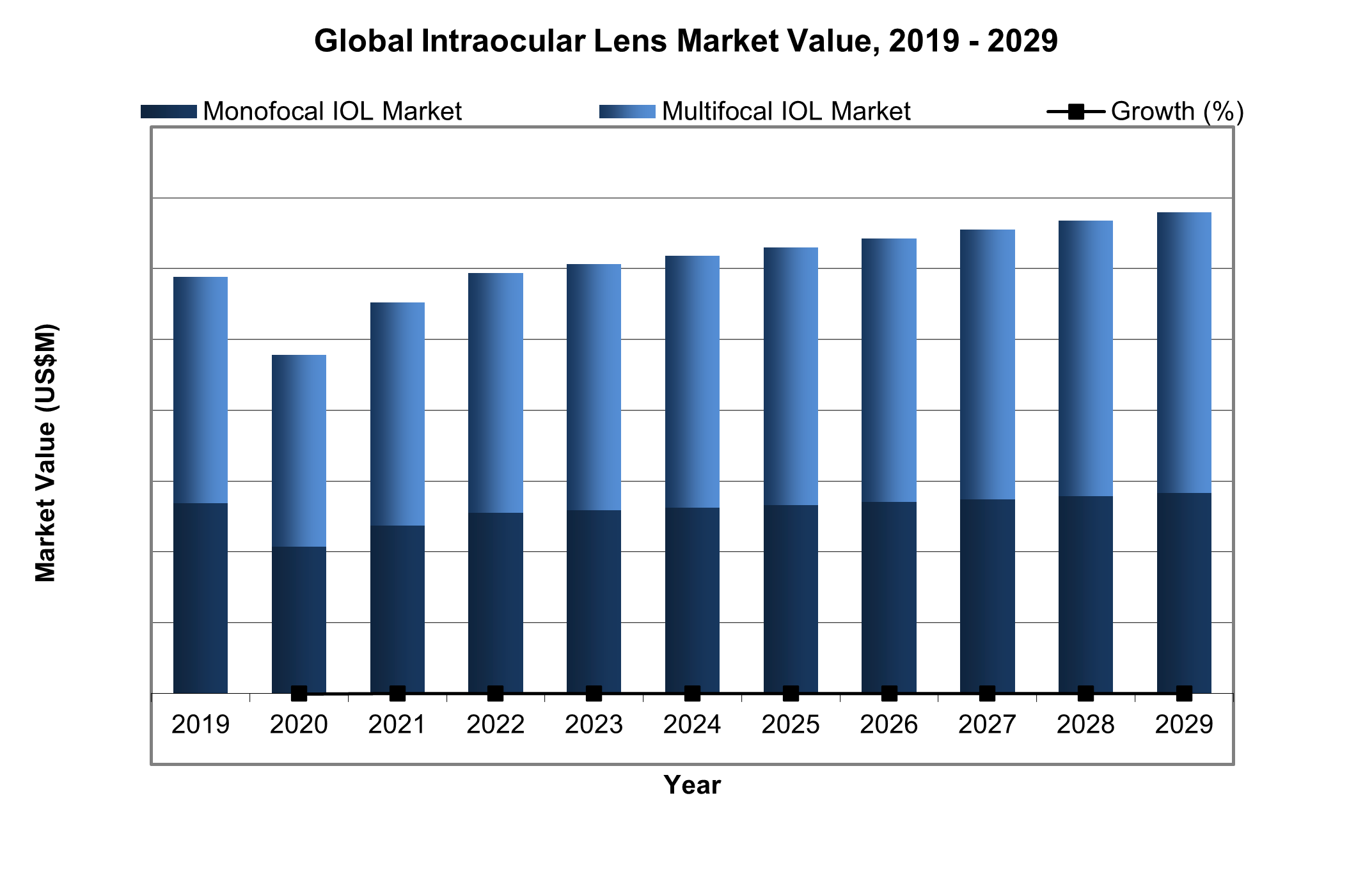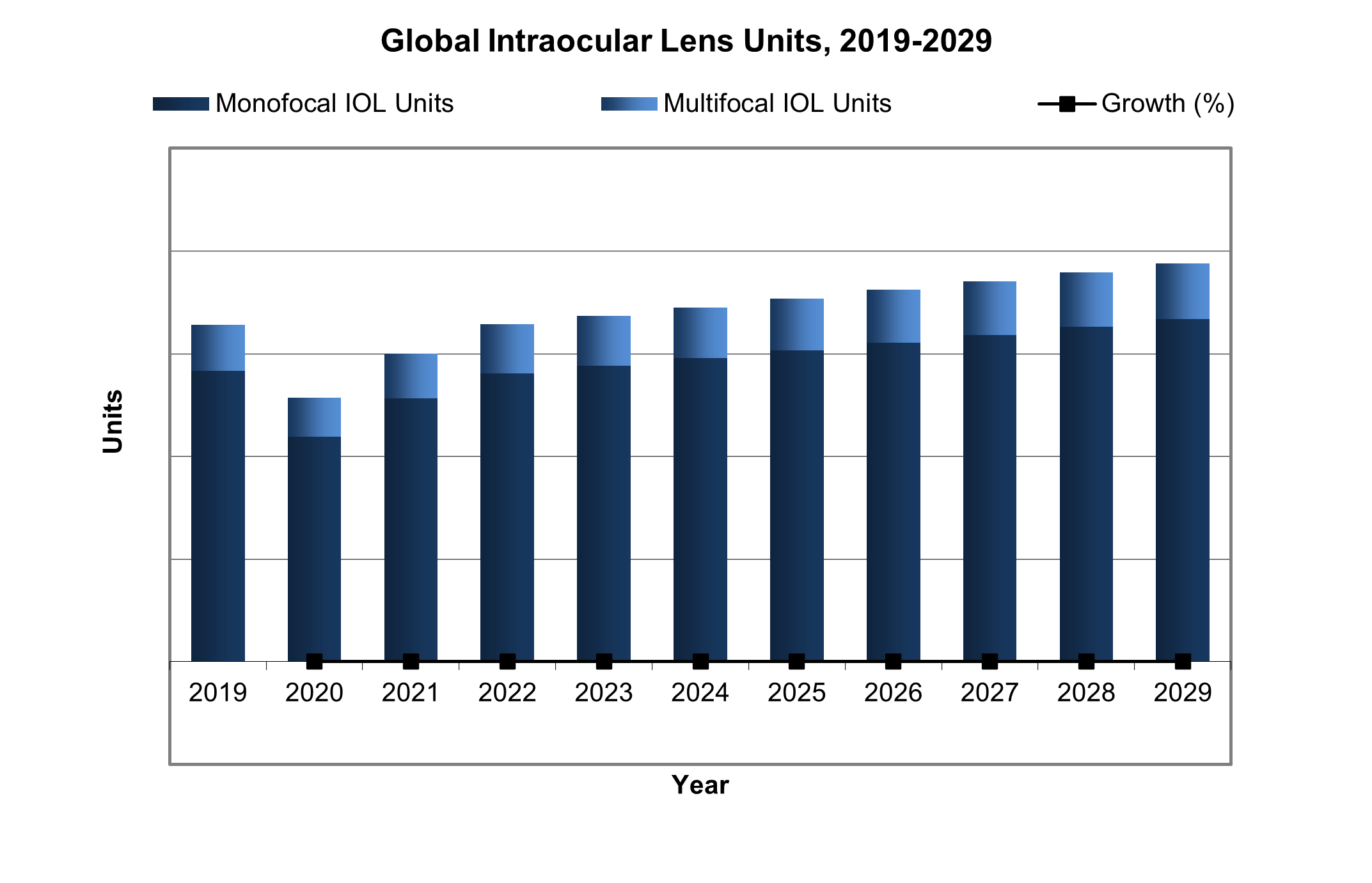 Intraocular lenses (IOLs) are synthetic lenses that are used for replacing the natural lens of the eye. Most commonly, they are used to replace lenses that have been clouded by cataracts. Approximately 30 million cataract surgeries were performed worldwide in 2022.1 Every year this number increases due to the increasing prevalence of eye conditions associated with the aging population, lifestyle changes and other factors.
Intraocular lenses (IOLs) are synthetic lenses that are used for replacing the natural lens of the eye. Most commonly, they are used to replace lenses that have been clouded by cataracts. Approximately 30 million cataract surgeries were performed worldwide in 2022.1 Every year this number increases due to the increasing prevalence of eye conditions associated with the aging population, lifestyle changes and other factors.
Several types of IOLs are used for cataract surgery. Globally, cataracts are a major contributor to visual impairment. In low and middle-income countries, cataracts are accountable for over 50% of blindness cases.2 The most common IOL is the monofocal IOL, which allows for focus at a fixed distance. Other types of IOLs, such as multifocal and accommodative lenses, which allow the patient to have different focusing powers within the same lens. Multifocal lenses have regions within the lens that allow for viewing close and distant objects. Accommodative lenses best simulate the natural lens of the eye by taking advantage of the natural musculature of the eye to physically change the refractive properties of the IOL.
As per the “Global Intraocular Lens Market Value, 2019-2029” chart, the multifocal IOL market compromised more than half of the total IOL market based on the 2022 market value.3 This trend is expected to be observed over the forecast period, with the multifocal lens market gaining market shares each year. Despite this fast growth, multifocal IOL units composed no more than 15% of the total IOL units sold in 2022 globally. This disparity is due to the high average selling price (ASP) of multifocal lenses.
In 2022, the ASP for multifocal IOLs were almost eight times higher compared to monofocal IOLs.3 This will remain one of the main factors limiting the high growth of multifocal IOL over the forecast period, despite its numerous advantages. This article will discuss the main driving factors for the continued worldwide growth of IOL.

Aging of the Population Driving IOL Market Growth
Worldwide growth in IOL can be mainly attributed to the aging of the population. As global healthcare has improved, the average lifespan of the population has expanded. While this is a positive outcome, it also implies that individuals have a higher likelihood of reaching an age where they may encounter age-associated conditions, such as cataracts. Consequently, rise of an aging population directly correlates with the rising incidence rate of cataracts, along with the need to address it.
Common age-related eye conditions include presbyopia, glaucoma, dry eyes, age-related muscular degeneration, cataracts and others. According to the World Health Organization, at least 2.2 billion people have a near or distance vision impairment with at least 1 billion of these cases being preventable.4 The main condition causing distance vision impairment or blindness are cataracts, which affects around 95 million people globally.4
Consequently, the need for affordable and effective treatment is essential to reduce morbidity associated with cataracts. Therefore, companies have to be prepared to respond to the increasing demand for cataract surgeries.
A number of major competitors in the IOL market are benefiting from this market growth, as well as some newer competitors that are bringing novel technology into the market. The main competitors in the global IOL market are Alcon, J&J Vision Care, and Bausch & Lomb.
Increased Incidence of Eye Conditions
Globally, the prevalence number of cataracts increased by almost 130% from 1990 to 2019.5 This can be attributed to multiple factors. One such factor is lifestyle changes. Specifically, increased screen time and exposure to digital devices contribute to earlier onset of vision problems which boosts the demand for IOL. Digital eye strain (DES) encompasses a range of ocular symptoms which arise from prolonged usage of digital electronic devices.
The COVID-19 pandemic’s lockdown measures curtailed outdoor activities for people of all ages, leading to increased screen time. Based on the statistics, the prevalence of DES symptoms in children grew to 55%.6 Certain studies indicate that blue light exposure emitted by digital screens may induce oxidative stress within the lens of the eye, potentially playing a role in the development of cataracts. Oxidative stress arises when there is an imbalance between the production of reactive oxygen species (ROS) and the body’s capacity to counteract them. This form of oxidative damage is thought to contribute to a range of eye-related conditions, including the formation of cataracts.7 It is important to note that there is still a lot of debate on this topic as some studies suggest that factors other than ultraviolet (UV) light exposure might play a more significant role.
Prevalence of Diabetes
In 2021, every 1 in 10 adults was living with diabetes, which accounts for more than 520 million people.8 By 2045, this number is predicted to reach 782 million according to the International Diabetes Federation.8 Individuals with diabetes have a notably elevated risk, ranging from 2 to 5 time higher, of developing cataracts, which often manifest at an earlier stage in their lives.
There are multiple biological mechanisms that contribute to the increased risk of developing cataracts. Most commonly, elevated levels of blood sugar in diabetes initiate a phenomenon known as glycation, whereby surplus sugar molecules bind to proteins within the lens of the eye.9 This interaction results in a transformation of the structure and functionality of lens proteins, inducing a cloudy and less transparent appearance. This opacity subsequently triggers the development of cataracts. Therefore, the increasing prevalence of diabetes significantly impacts cataract surgeries.
Intraocular Lenses Research and Development
As the demand for IOL rises each year, there are numerous clinical research studies aiming at improving the technology. A specific area of research centers on enhancing biocompatibility, achieving improved visual quality and adjustability, minimizing surgical incisions and mitigating complications such as posterior capsular opacification and ophthalmitis.10
Additionally, a lot of clinical research aims at advancing optics. This encompasses the creation of multifocal and accommodative IOLs, which allows individuals to achieve clarity of vision across different distances without relying on eyeglasses. The customization of IOL is another research area investigating personalized IOLs to cater to the distinct visual requirements of each patient, thereby optimizing their vision after surgery. Moreover, ongoing studies are delving into IOLs which can be modified after being implanted, allowing for precise adjustments to refine the patient’s visual acuity.11
Closing Points
The global intraocular lens market has been evolving and growing dramatically in the past, and it is expected to maintain growth as the needs of the population increase. With the high cost of most biomaterials, North America and Western Europe represent the highest percentage of the total market. Moreso, IOLs are slowly becoming more prevalent across the globe. Alcon remains the leading company in the market worldwide.
For further insights and more granular market data, please see the report Ophthalmic Device Market Size, Share, and Trends Analysis – Global – 2023-2029 by iData Research.

About the Authors
Kateryna Hronska is a senior research analyst at iData Research. She works on research projects regarding the medical device industry, publishing the Global Diagnostic and Interventional Ophthalmic Device research report.
Kamran Zamanian, Ph.D., is CEO and founding partner of iData Research. He has spent over 20 years working in the market research industry with a dedication to the study of medical devices used in the health of patients all over the globe.
About iData Research
For 19 years, iData Research has been a strong advocate for data-driven decision-making within the global medical device, dental, and pharmaceutical industries. By providing custom research and consulting solutions, iData empowers its clients to trust the source of data and make important strategic decisions with confidence.
Citations
- Basaldua, B. (2023, March 3). The Future of Cataract Surgery. iOR Partners | Office-Based Surgery.
- Tognetto, D., & Giglio, R. (2021, October 1). Artificial Intelligence Applications and cataract management: A systematic review. Survey of Ophthalmology.
- iData Research Inc. Global Diagnostic and Interventional Ophthalmic Device Market – 2023. Published ___ 2023. Accessed ___, 2023.
- World Health Organization. (n.d.). Vision Impairment and blindness. World Health Organization.
- Fang, R., Yu, Y.-F., Li, E.-J., Lv, N.-X., Liu, Z.-C., Zhou, H.-G., & Song, X.-D. (2022, November 12). Global, regional, national burden and gender disparity of cataract: Findings from the global burden of disease study 2019 – BMC public health. BioMed Central.
- Kaur, K., Gurnani, B., & Nayak, S. (2022, October). Digital Eye strain- A comprehensive review. Ophthalmology and therapy.
- Nita, M., & Grzybowski, A. (2016). The role of the reactive oxygen species and oxidative stress in the pathomechanism of the age-related ocular diseases and other pathologies of the anterior and posterior eye segments in adults. Oxidative medicine and cellular longevity.
- Diabetes around the world in 2021. IDF Diabetes Atlas. (n.d.).
- Kiziltoprak, H., Tekin, K., & Inanc, M. (2019, March 15). Cataract in diabetes mellitus. World journal of diabetes.
- Luo, C., Wang, H., & Chen, X. (2022, May 23). Recent advances of intraocular lens materials and surface modification in cataract surgery. Frontiers.
- Salerno, L. C., Tiveron, M. C., & Alió, J. L. (2017). Multifocal intraocular lenses: Types, outcomes, complications and how to solve them. Taiwan journal of ophthalmology.









